#Taxi Hire Noble Park
Explore tagged Tumblr posts
Text
Enjoy The Convenience of Booking a Cab to the Airport Online

Earlier, we have all witnessed and gone through the struggle of waiting for cabs to go to the airport. The struggle didn’t just end with waiting for cabs. The prices they demanded and the tantrums the driver showed were all a significant part of the struggle. However, today, with the advent and ease of online cab booking, reaching the airport on time has become so convenient and easy.
We will discuss some benefits of booking a taxi in Cranbourne.
Booking a cab online to the airport on time has become convenient and hassle-free. Here are some added advantages of online taxi hire-
The cabs are registered with the service providers. Therefore, you can be sure of the drivers' and the cars' reliability. This has made bookings easy and safe from anywhere at any time of the day.
Booking cabs is not tough at all. If you have an Android phone and access to the internet, you can easily book them. They are an efficient mode of transportation because they guarantee on-time arrival at the airport and enable GPS tracking of the quickest route. The booking procedure is super simple.
These cabs are reliable and comfortable. You needn’t hustle on a train or bus. You can sit comfortably until you reach the airport.
Another great benefit of booking cabs to the airport is the ease of payment. There are multiple payment modes. You can also pay online to avoid cash transactions if you wish.
There are multiple choices when it comes to selecting Taxi Hire in Noble Park. Therefore, you can choose the one you like.
They help you feel rejuvenated and at ease because you know you'll get where you're going on schedule.
Always check the driver’s information and know the company’s rules and policies well. You must also consider whether they will be able to meet your needs for services in terms of delivery.
0 notes
Text
Top Features of a Reliable Taxi for Hire Service

0 notes
Text
Amazing Beaches of Pakisran Turtle Beach Karachi

Turtle Beach Karachi Turtle Beach Karachi Pakistan. Situated between Hawke's Bay and Sandspit, this ocean side is one more reproducing spot for interesting green turtle species. You can detect these turtles sneaking all through the ocean for the most part after nightfall in the cold weather months. The charming blue water is one of the fundamental attractions of this ocean side. Table of Contents Turtle Beach Karachi Maps and Locations Turtle Beach Karachi is located a short distance from the city of Karachi, away from the hustle and bustle of the city, offering the perfect atmosphere to relax and enjoy the tranquility with whispering water. .. Turtle Beach Weather and Temperatures

Turtle Beach Weather The weather here is warm. It's not unpleasantly warm or cool, but it's quite comfortable compared to the weather and temperatures in Karachi. In most cases, the weather is cool in the evenings and nights.

Turtle Beach Distance from Karachi Located 30km southwest of the capital Karachi. You can get on at a reasonable price at any time of the day or night. You can hire a local taxi or take advantage of Careen or Uber services.
Turtle Beach Karachi is located between
Hawke's Bay and Sandspit, and this beach is another breeding ground for rare green turtle species. You can usually see these turtles crawling in and out of the sea after sunset during the winter. The enchanting blue waters are one of the main attractions of Turtle Beach Karachi. 4 Turtle Beach Karachi is one of the most famous tourist and picnic spots in Karachi. Turtule beach karachi Natural sandy beach without rocks or coral reefs. In summer, rare species of green and olive ridley turtles spawn on beaches in the southwestern part of Karachi, especially Sandspit Beach, Hawks Bay Beach and Turtle Beach. The city's sandy beaches are one of 11 beaches, including Hawke's Bay, Turtle Beach and Sandspit. An important beach in the world where sea turtles spawn. Nearby rocky beaches, including Cape Monze, feed and feed turtles with a variety of aquatic plants. This species of turtle is also found in Balochistan. Turtle Beach Karachi is also famous for its crystal clear waters that fascinate travelers. Turtle Beach Karachi has many huts. This is good for visitors. Government wwf and many other NGOs are working on this kind of protection at turtule beach Karachi. Finally, for accommodation purposes, Turtle Beach has several huts. Most of them are equipped with furniture, electricity and heavy standby generators. There are also gas cylinders for cooking, private parking, guards and security guards. There is also a designated barbecue area and a terrace overlooking the sea, so you can enjoy the crispy texture of the fish caught here. These huts can accommodate up to 25 to 30 people at a time. That's why Turtle Beach is a must-see. At the end of spring, these holes can be seen along the beach. These turtles appear after dark, mainly during the calm times of dawn and dusk. In the photo you can see trucks like agricultural trucks that these turtles pull along the coastline. To advance turtle conservation technology, the World Wildlife Fund (WWF) has set up wetlands on the Sandspit Ocean side. In addition, these coasts are home to a variety of marine life, some of which include green growth, snails and crabs. Turtle Oceanside Karachi Cottage Turtle Oceanside Karachi offers a variety of fun cottages for families to stay by the sea easily and peacefully. For the rest of the reasons, the Turtle Oceanside Karachi has different types of huts. The cost of a luxury hut in Turtle Oceanside Karachi is usually Rs per day. From 15,000 /-Rs. It is in the range of 50,000 /-. needs. You can also rent a parking space in the cabin. Great Place for Family Cook Out Turtle Oceanside West Karachi has an oceanside called the Turtle Oceanside, also known as the Bird of Prey Narrows Oceanside. It is also called the Karachi Shanside, a particularly famous landmark. Given the noble blue water and the sunshine that bounces off it, it is a famous and interesting place for families and travelers. One of the most unusual reptile populations on the planet lives on this side of the ocean. It's something other than your typical ocean side. Similarly, Turtle Oceanside Karachi is one of the few coasts where sea turtles spawn and are found. We really want to do this every year, not just once. In addition, Turtle Oceanside Karachi has a number of great luxury hideaways and cabins. Turtle Oceanside Karachi is the perfect place to spend a day celebrating with your family or gathering with friends, relaxing on the brilliant sands of the ocean and enjoying a heavenly drink. Read the full article
0 notes
Link
We are a Melbourne based taxi company, offering quality services with a wonderful riding experience. Taxi Noble Park VIC provide various taxi cab services such as business taxi, airport taxi, local taxi, etc. To hire the noble park cabs, call at 0468854280 or you may book a noble park cab online.
0 notes
Link
Regardless of where you are in Melbourne, the cabs give you benefits. Moreover, cab transportation offers, in contrast to the prevalent assumption, considerable advantages.
0 notes
Link

Greater Dandenong City has huge options to explore like Noble Park, Dandenong, Bangholme, etc. To visit here, Hire Dandenong Taxi Cabs now!
0 notes
Text
Get Your Christmas Gifts Delivered on-time by Taxi Delivery Service
Since Christmas is approaching, you must be planning to send gifts to your loved ones. You must be wondering about choosing a delivery service that can deliver your parcel at the right place, on time, and safely without causing any damage to the gift. In this case, your one-stop solution will be to hire a taxi delivery service. You can hire them to get your parcels delivered easily.
Taxi services that provide such services are trustworthy as well as have the proper knowledge. They have a proper idea about the routes and which routes to take during busy hours. This helps to deliver your parcel at the right time and the right place.

How To Book Taxi Delivery Service?
To book this service, you can call them or visit their website, then choose their delivery service option, and fill in the details. Such services are available 24/7 hence time will not be a problem for you to send your Christmas gifts to your loved ones. After opting for delivery service through taxi hire in Rowville, the package will be directly picked up from your location and will be sent to your loved ones’ place as per instructions.
What Are The Advantages Of Hiring A Taxi Delivery Service?
Opting for taxi hire in Noble Park for delivering goods has some great advantages that make them highly competitive in the market. Given below are the key benefits of opting for a taxi delivery service:
Taxi delivery service provides fast delivery of your parcels
Many taxi delivery service offers 24/7 services
Some of the taxi delivery services provide delivery even on holidays
What Is The Cost Of Hiring A Taxi Delivery Service?
The cost of taxi delivery service is different than other delivery services. It depends on different factors and different situation, such as rate of the mileage, staff required, time taken, and vehicle involved. The taxi companies offer different options to meet the requirements of the customers. Moreover, the cost of the service depends upon the type and size of package. Hence, if your gift consists of larger items, then the cost might be a bit higher.

Therefore, these were some of the benefits of taxi services for delivering parcels. However, when hiring a taxi delivery service, you must opt for well-known and experienced taxi companies, as they are capable enough to deliver your gift items safely at the right place, and on the right time.
Infographic URL:- https://bit.ly/2s2g2kJ
0 notes
Text
Recollections of Croatia
First stop Dubrovnik. We encountered insane traffic! Thank goodness for our taxi driver, who found us our accommodation, then dropped us off a short way from the old city. We were assaulted by heat, tourists, extortionist prices, and general mayhem. So in short, we were over the place pretty quickly. We found the old city similar to Kotor, but with a completely different feel, the place is very commercialised, and basically, ruined by the hordes of tourists, who mainly come from the many cruise ships that visit there daily. And they rip you off-you get charged for everything. To walk around the walls-one of the main attractions, you have to pay about $45 each! Yeah, right. Anyhow, we did the best we could, and left after a few hours, catching a bus back to our BnB to recover. They also don't accept euro in Croatia either, so we are back to changing money again. I thought eu stood for "common" market? And if you so find somewhere that accepts euro, you pay 1.5 times the going exchange rate. So for the next couple of weeks we are using kuna :(
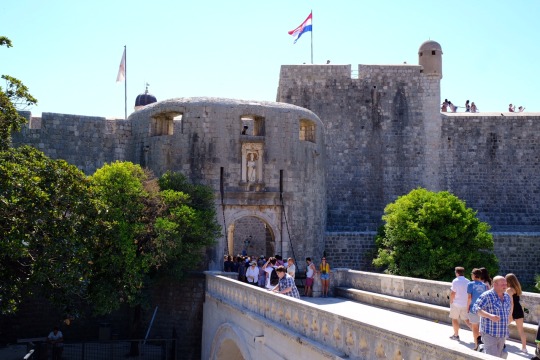
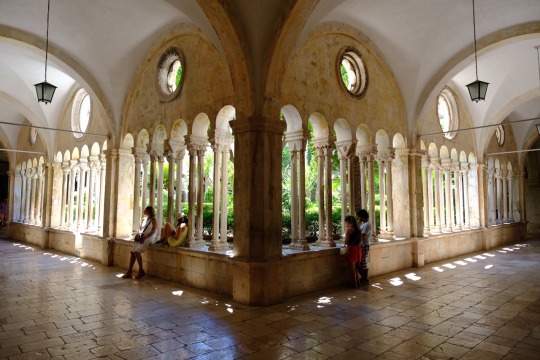

We rose early to catch our 3 hour ferry to Hvar, and really like it here-much more chilled. We moseyed round the city, and climbed up to the old fort, which was well worth the visit. It includes its own macabre dungeon, deep into the rock. You can see from the below pic how tiny the cells were. We had a picnic lunch overlooking the old town before winding our way down to do some more exploring. Next task was to find our accomodation, which unfortunately is located on the top of a hill! Laden with backpack we started the ascent, only to get briefly lost. We eventually found the place and its pretty nice. Back into the city for a glass of wine and a delicious meal of sea bass and grilled vegetables. Our starter was a “Kapitan's Platter"- bread and a sampling of tuna pate, grilled octopus, cured salmon, pickled onion under anchovies and sardines, some delicately prepared soft shrimps which were amazing. It was a lovely start to the meal. We chose a restaurant overlooking the harbour, with boats coming and going nineteen to the dozen.
Today, Sunday, we did adventure sport - hired a scooter and went buzzing over the rugged mountain interior of the island to Stari Grad-home to Tvrdalj castle - built by a poet, Petar Hektorovic, in the 16th century. During the that century, the island of Hvar came under attack from the ottoman Turks. Hektorović, one of the local nobles, undertook to fortify his house so that it could act as shelter for the local citizens.
Tvrdalj is a well-preserved Renaissance building, with a long closed facade on the seaward side, to protect it from attack. The interior courtyard contains a sea-water fishpool, enclosed by a vaulted and arcaded terrace. Next to it is a tower with a dovecote. The living quarters, together with the servant quarters, and several wells, are arranged around the pool. Behind the main buildings is a walled garden where Hektorović cultivated herbs and medicinal plants. A series of inscriptions are set into walls of the mansion in Latin and Croatian. Those in Croatian are considered to be some of the oldest extant. The castle boasted one of the first indoor toilets in the whole of Europe..
We had a picnic lunch in the garden.
The island is a massive rocky outcrop, really. Over the centuries the locals have cleared patches of land, some just the size of a large room. They pile the cleared rocks to form walls. Big walls, you have never seen so many rocks. They form a loosely formed patchwork up and down the steep hillsides in between the cleared plots. In these, they grow olives, lavender, vines and probably other crops in the meagre soil. The views on our drive consisted of horizon hugging sea, steep mountains and seaside hamlets far below. And of course, ship traffic, with various sized craft doing their summer holiday thing.
On our way back to Hvar we stopped for a swim at a small beach village of Milia. Water colder than we are used to, but very refreshing. The place was far less crowded too, quite a relief!
Nicky proved to be a brilliant pillion rider - far better bike passenger than car passenger, probably cos she couldn't see what I was doing 🤣🙄😳🛵
The next morning we trundled down the hill with our backpacks, found a comfy and shady spot to wait out the time before we caught the ferry. It was a great chilled time watching the tourists pass by and drinking the inevitable iced coffee. The ferry trip was uneventful if a little rough and there was a very dark cloud hovering which later turned out to be a result of bad fires in the forest in Split, our destination. We have been rather bemused by the inability of people in this part of the world to understand the mechanics of a queue.... it clearly is not part of their upbringing and is every man for himself so to speak. We had several queue jumpers in Hvar, one of which Nicky approached to point out the etiquette required, but it was like water off a ducks back. However in disembarking they were at the very back of the queue and were helpless in advancing forward... we smiled inwardly.

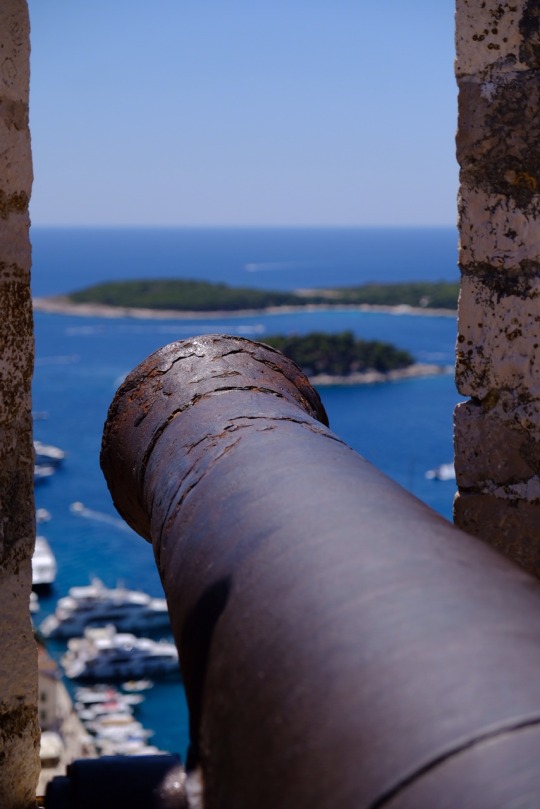


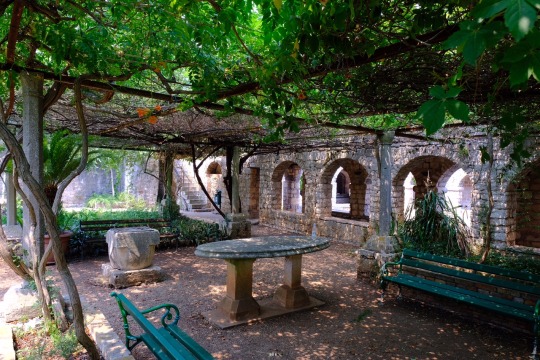
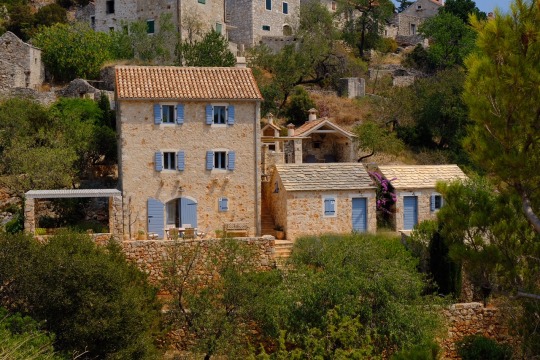
Split was another cobblestoned smorgasbord of palaces, churches, alleyways and ruins but in this case the centre of it all was a palace built by the Roman emperor, Diacletian, at the turn of the 4th century AD. It's a massive structure occupying a couple of modern city blocks. Within the palace Diacletian built himself a mausoleum, fitting to someone deified as a son of the god Jupiter. He even had a sphinx brought in from Egypt as part of the decoration. Later, around the 7th century AD, the Catholic Church got its own back for all the Christians that Diacletian had killed and converted his mausoleum into a cathedral complete with a magnificent bell tower which we just had to climb. There were 9 bells in there and Tony was waiting patiently for them to ring, which of course they did not, as I pointed out if they rang they would either deafen the people climbing up or cause them to go to an early grave. The view of the old city and harbour from the top was worth every steep step. Split had a lot more character/soul than Debrovnik and not as vastly and we were more drawn to it, possibly due to the old world aura created by some wonderful Dalmatian singers in the Vestibule of the palace. Maps are not their strong point and we spent a fruitless hour looking for a speciality coffee shop, D16, which we did eventually discover thanks to google maps - and the iced coffee was duly consumed ... feedback - needed a double shot of coffee. As you can see this is a theme throughout our trip 😋. This was the first time we cooked for ourselves as our B&B was fully equipped, just like at home.
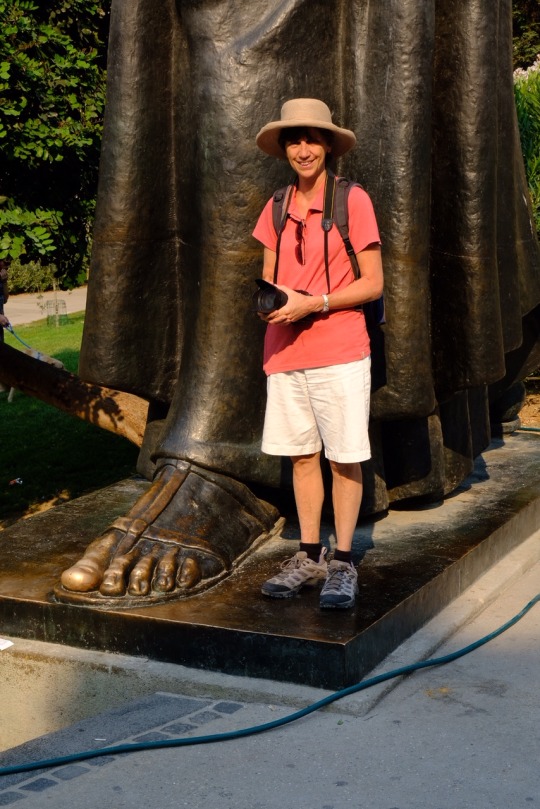
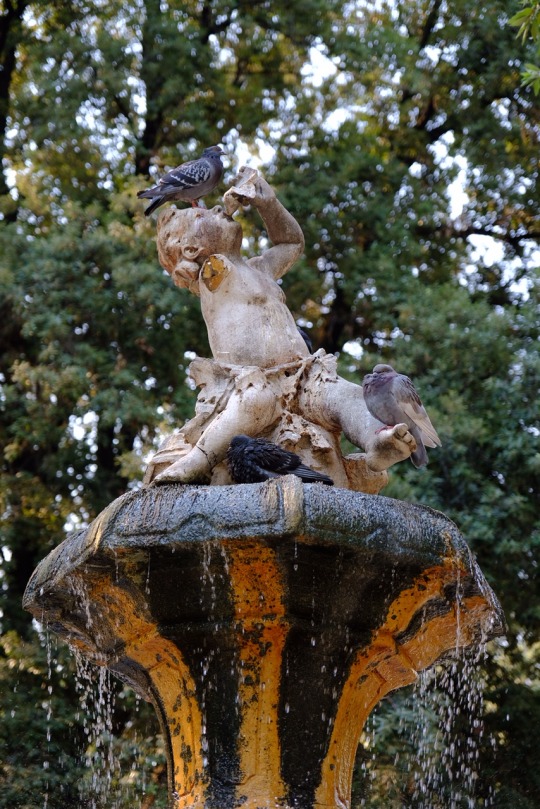
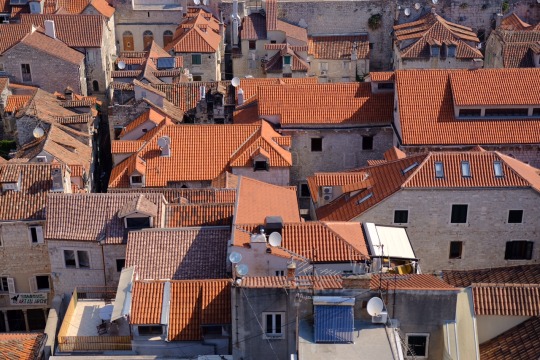
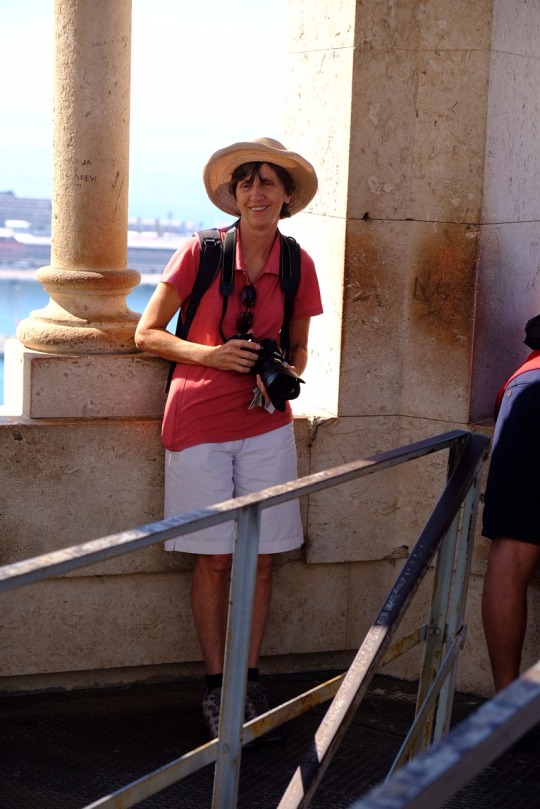
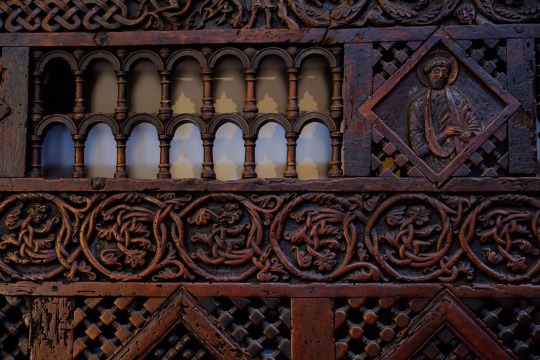
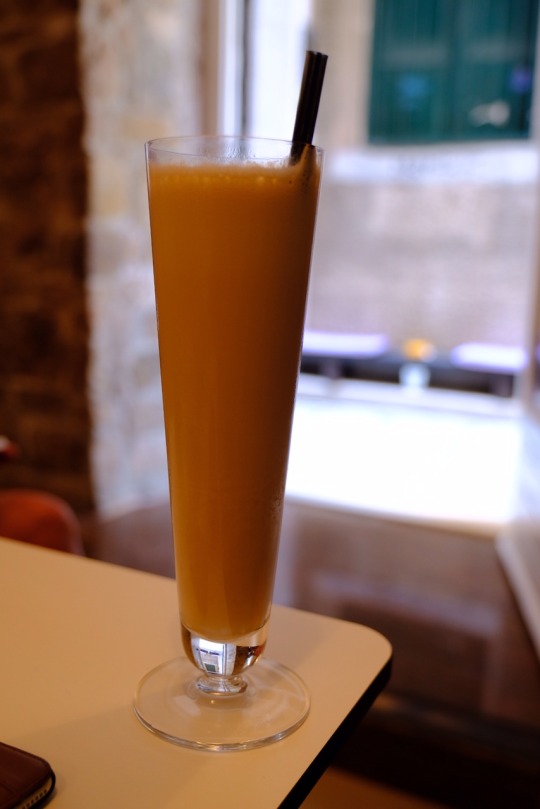
The next morning was an early start as we had to catch the bus to Plitvice. By now we were savvy to the ways of non queuing and while Tony put our bags in the undercarriage I was champing at the bit to give our tickets and secure a front seat on our gleaming red bus ...mission accomplished. The bus driver managed to spend at least 60% of the journey talking on his cell phone and while he had a hands free set his conversation was intrusive and he had several calls whereby he needed to handle his phone. My word if you thought woman could talk, you were mistaken.
Plitvice was a complete change to the dry stony places we have visited and is a green lush, forested (beech, spruce and fir trees) lake system. It is a 295 square km forest reserve and comprises a chain of 16 terraced lakes joined by waterfalls that extend into a limestone canyon. Walkways and hiking trails wind around and across the water and an electric boat transports trippers between the 12 upper and 4 lower lakes. You can also catch a bus within the national park to help you cover the major distances and all is included in your entrance ticket. Each year 1 million visitors are recorded and we reckon 75000 of those were here. We had the afternoon to explore amidst these 75000 others and saw what was recorded as the largest waterfall.....well clearly they have not seen Victoria falls.... and I must confess to feeling rather let down. However the next day we set off early to avoid the crowds and had a wonderful walk with many special sights. The colours of the lakes ranged from azure to green grey and blue. Apparently the colours change constantly depending on the quantity of minerals or organisms in the water and the angle of sunlight. One thing we noticed was the lack of bird life despite there being 157 species identified. There are also apparently brown bears that live here but we did not see them, fortunately. When we had finished we noticed the crowds escalating - they were back- but we had done what we wanted to do so all was good.
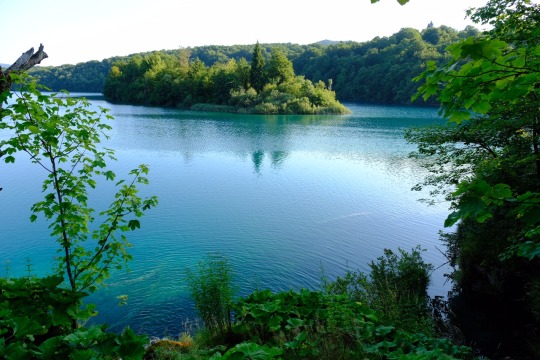
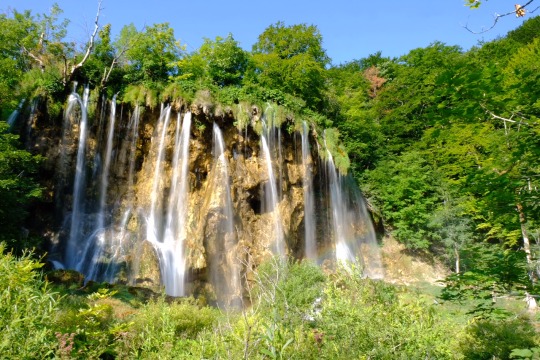
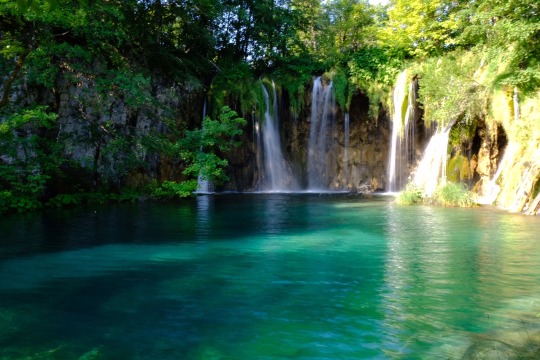

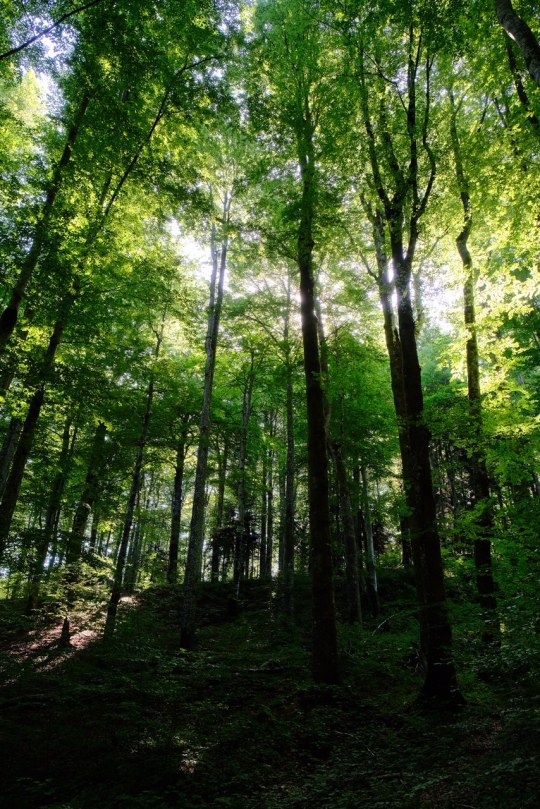
4 notes
·
View notes
Text
Vienna Alps – Austria’s Semmering and Rax In A Day
Vienna Alps. Did you know that the Alps are just an hour’s drive from Vienna? At the foothills of Europe’s largest mountain range, the Rax and Semmering create Alpine feelings. That said, you will find easy hiking paths, lovely historic villas and lush surroundings as well. In fact, the kind of things Empress Sissi, Sigmund Freud, baron Rothschild and many other Viennese already enjoyed. Here is my day’s guide to the Wiener Alpen.
Hiking In The Rax Alps
Taking the cable car up to the Rax summit is the quickest way to enjoy panoramic vistas. In less than 10 minutes you glide speedily across tree tops, Alpine meadows and rocky mountainsides. While the cable car is state of the art, it was the first touristic funicular in Austria some 95 years ago.
Up there at almost 1,600 meters, the limestone plateau opens up surreal vistas of mountains and valleys. There are several hiking paths connecting Alpine shelters with panoramic vistas. Where ever you walk creeping pines and protected rare plants accompany you.
If you just have two to three hours on the Rax, walk to Ottohaus shelter on a broad largely flat path along the mountain top, at 30 minutes from the funicular station at the top. In the winter you can take a guided snowshoe walk there in about 40 minutes.
In the spring and summer, the Rax Alpine Garden just underneath Ottohaus merits a visit: Imagine a carpet of lupines, columbines, milkwort, mountain avens, campions, and even edelweiss and gentian!
Another really scenic hike is to Luckerte Wand, an amazing rock formation including several caves, near the Rax Alps. You can hire your own private guide for the Luckerte Wand hike, which takes about two hours.
Location: Rax Seilbahn (funicular), 2651 Hirschwang an der Rax 86; Opening Times: end of April to early November
Alternative Option: Semmering
Being part of the Vienna Alps the Semmering saddle south of Rax will ring a bell with railway engineers. In the mid 19th century Carl Ritter von Ghega broke ground building the world’s first normal lane mountain railway: the Semmeringbahn. While you can hike along the historic railway track and its iconic bridge are a UNESCO World Heritage Site mostly modern Austrian Railway carriages now rush through between Vienna and Graz.
Probably the most exciting place to visit is Zauberberg mountain, where my kids learnt to ski. If you are not into winter sports, take a hike in the summer. Like at the Rax Alp, you can take a cable car up to the mountain top. A little lower than Rax’s hilltop station, Liechtenstein mountain lodge is at 1,340 meters above sea level.
For short hikes there are three paths allowing between 30 minutes and three hours of hiking between Sonnwendstein and Hirschenkogel mountains. Alternatively, you can join a wildlife biologist on a private day hiking trip to Semmering. Through July and August, the cable car operates daily, otherwise Thursday to Sunday (as per 2019).
Society Spot Reichenau
Once THE summer resort of the Viennese society, the town and climatic spa of Reichenau has left an air of nostalgia. Against the backdrop of the Viennese Alps quaint town houses mix with stunning villas. By the way, it is from here that Vienna gets his tap water from!
Just next to a mountain range a riverside hiking path leads to a manicured park with flower beds and a lake. Whereas the impressive wooden pavilion once resonated with folk choirs and brass music bands it now houses farmers’ markets and festivals.
Close to the center, affluent Viennese had followed Empress Sissi and Emperor Francis Joseph in setting up camp. After the Southern Railway connected Reichenau with Vienna in the mid 19th century a villa construction boom started in this sleepy town. Across the Schwarza river the Sisi Schloss, aka Rudolfsvilla, became a summer retreat for the young Habsburg family. Though not open to the public you can see various paintings, historic photos and information on the outside wall.
If you are a Sigmund Freud fan, pass by the hotel he used to stay when in Reichenau. At Hotel Knappenhof, general manager Brigitte Klenner-Kaindl has collected various original objects and documents. Among them is case study ‘K’ about the sister of the hotel’s builder, and the only BBC interview of Sigmund Freud. Do contact the hotel in advance if you would like to see the collection.
On the other side of Reichenau you will find pink Villa Wartholz. Until 1918, it was also the residence of the last Habsburg Emperor and his wife, Charles I and Zita. Erstwhile a reclusive society spot for imperials, nobles and celebrities, you will still find it difficult to access the privately owned villa.
Instead, head around to the revitalised Wartholz nursery for coffee and cakes (Wednesday to Sunday). If you visit during the week, sneak into the art gallery of nearby Schloss Rothschild to see the castle’s interiors. In the late 19th century, Baron Nathaniel Rothschild built the magnificent castle to outshine the Habsburg neighbours.
Looshaus am Kreuzberg
While the Reichenau villas all display an elegant historic chic one famous dwelling went against the trend. High on the hills of neighbouring Payerbach Modernist guru Adolf Loos built a retreat for Viennese industrialist Paul Khuner. Far from purist, however, Loos chose to develop the local traditional farmhouse style to create a modern and comfortable home. At first sight, it looks like a charming old farmhouse but reveals quirky features close up: For example, in order to operate the more durable but heavy metal window shutters, Loos let them roll on small wheels along the facade!
When we had lunch on the panorama terrace of the Looshaus hotel and restaurant I inspected the interiors. At first, the side entrance felt small and the ceiling hovered closely above my head like in a usual farmhouse. Unexpectedly, however, the main restaurant room (former living room) opened up into a lofty gallery with two-storey panoramic windows inviting a lush mountain scenery inside. The tasteful 1930s design even included Loos’ two original corner seats near a fire place.
Just behind the house, small paths lead through a sun flooded forest of birches, beeches and fir trees: perfect for a relaxed stroll to soak up nature.
How To Get To the Vienna Alps
You can take fast trains from Vienna to Payerbach-Reichenau in 1.5 hours, and then hire a taxi to go around. Alternatively hire a private car and driver from Vienna – email me at [email protected] – or simply rent a car.
explore more Day Trips From Vienna go back to Vienna Unwrapped homepage
The post Vienna Alps – Austria’s Semmering and Rax In A Day appeared first on Vienna Unwrapped.
from Cheapr Travels https://ift.tt/2m0gpK1 via https://ift.tt/2NIqXKN
0 notes
Text
Explore your Desired Destination by Hiring a Taxi in Australia
Hiring a taxi service in Cranbourne for reaching your destinations surely will save your precious time and escapes for the most part of the annoyance and power obligatory to ascertain convey after exodus at the airport’s exit. Booking the finest taxi provider in Cranbourne will truly escape your sufficient time with a taxi offered to pick you up in a lesser amount of time of placing a booking.
The dependable Cranbourne Taxi members of staff are all dutiful, skilled and specialized drivers. By taking on the drivers that execute airport transports on a daily basis, the drivers should encompass great driving proficiency and a superior indulgent of the speediest roads and the jams guide for any explicit city. By this method that traveling with the well-experienced driver will offer an absolute assertion, steadiness, and safety.
Places you can explore by booking a Cranbourne Taxi
Cranbourne is a town in Melbourne, Australia. You can discover Australia’s vivacious multi-glorifying cities, enormous sand isles, rainforests and one of the stirring natural marvels – The Great Barrier Reef. Ascertain the inventory of pinnacle magnetism in Australia such as the famous Opera House of Sydney, Marine Park near Great Barrier Reef, Harbour Bridge of Sydney, National park, and many more. If you are going for a vacation in Cranbourne for the first time, the thing you must require to make sure earlier is that you have praiseworthy taxi service that will assist you to accomplish your considered necessary destination without any trouble.
Online Taxi Service Providers are Worthy
The online taxi service providers proffer you the very expedient way of traveling all over the town. They are able to take you to the bus station, to the railway or subway station, to the airport or to any other place you want to go. They will catch you up from wherever you are standing and will convey you to your desired place within time. When you book a taxi service, you bygone necessitate being seeking for the greatest and speedy roads, no more need of intricate maps to locate out where you are. You just have to tell the taxi executive the desired place you want to go and they will drop you there without any trouble. Their policy assures that you will reach your destination not only on time but also satisfied and calm.
The comfort of the Passengers is the First Thing
All of the taxi drivers be acquainted with the region of Noble Park well and can drop you to the desired place devoid of any difficulty. The Noble Park Taxi service providers keep all their cars in the optimum conditions so that their taxis always be maintained flawless, both interior and exterior. The taxis of the online taxi services have air condition in them, so the climate cannot be the reason for any trouble. They provide comfortable and cozy cars, so there also is no problem in relaxing of the passengers. Only one thing is to do is get inside and get pleasure from the ride. It is important for the taxi driver that you reach your destination within time and peacefully.
Author’s Bio: Yaman Shakya is a content writer by the profession who currently works for Seoxport.com (a Digital Marketing Company) in Ambala Cantt.
0 notes
Text
How To Know Whether You Are Opting For The Right Taxi Hire Or Not?

0 notes
Text
Vienna Alps – Austria’s Semmering and Rax In A Day
Vienna Alps. Did you know that the Alps are just an hour’s drive from Vienna? At the foothills of Europe’s largest mountain range, the Rax and Semmering create Alpine feelings. That said, you will find easy hiking paths, lovely historic villas and lush surroundings as well. In fact, the kind of things Empress Sissi, Sigmund Freud, baron Rothschild and many other Viennese already enjoyed. Here is my day’s guide to the Wiener Alpen.
Hiking In The Rax Alps
Taking the cable car up to the Rax summit is the quickest way to enjoy panoramic vistas. In less than 10 minutes you glide speedily across tree tops, Alpine meadows and rocky mountainsides. While the cable car is state of the art, it was the first touristic funicular in Austria some 95 years ago.
Up there at almost 1,600 meters, the limestone plateau opens up surreal vistas of mountains and valleys. There are several hiking paths connecting Alpine shelters with panoramic vistas. Where ever you walk creeping pines and protected rare plants accompany you.
If you just have two to three hours on the Rax, walk to Ottohaus shelter on a broad largely flat path along the mountain top, at 30 minutes from the funicular station at the top. In the winter you can take a guided snowshoe walk there in about 40 minutes.
In the spring and summer, the Rax Alpine Garden just underneath Ottohaus merits a visit: Imagine a carpet of lupines, columbines, milkwort, mountain avens, campions, and even edelweiss and gentian!
Another really scenic hike is to Luckerte Wand, an amazing rock formation including several caves, near the Rax Alps. You can hire your own private guide for the Luckerte Wand hike, which takes about two hours.
Location: Rax Seilbahn (funicular), 2651 Hirschwang an der Rax 86; Opening Times: end of April to early November
Alternative Option: Semmering
Being part of the Vienna Alps the Semmering saddle south of Rax will ring a bell with railway engineers. In the mid 19th century Carl Ritter von Ghega broke ground building the world’s first normal lane mountain railway: the Semmeringbahn. While you can hike along the historic railway track and its iconic bridge are a UNESCO World Heritage Site mostly modern Austrian Railway carriages now rush through between Vienna and Graz.
Probably the most exciting place to visit is Zauberberg mountain, where my kids learnt to ski. If you are not into winter sports, take a hike in the summer. Like at the Rax Alp, you can take a cable car up to the mountain top. A little lower than Rax’s hilltop station, Liechtenstein mountain lodge is at 1,340 meters above sea level.
For short hikes there are three paths allowing between 30 minutes and three hours of hiking between Sonnwendstein and Hirschenkogel mountains. Alternatively, you can join a wildlife biologist on a private day hiking trip to Semmering. Through July and August, the cable car operates daily, otherwise Thursday to Sunday (as per 2019).
Society Spot Reichenau
Once THE summer resort of the Viennese society, the town and climatic spa of Reichenau has left an air of nostalgia. Against the backdrop of the Viennese Alps quaint town houses mix with stunning villas. By the way, it is from here that Vienna gets his tap water from!
Just next to a mountain range a riverside hiking path leads to a manicured park with flower beds and a lake. Whereas the impressive wooden pavilion once resonated with folk choirs and brass music bands it now houses farmers’ markets and festivals.
Close to the center, affluent Viennese had followed Empress Sissi and Emperor Francis Joseph in setting up camp. After the Southern Railway connected Reichenau with Vienna in the mid 19th century a villa construction boom started in this sleepy town. Across the Schwarza river the Sisi Schloss, aka Rudolfsvilla, became a summer retreat for the young Habsburg family. Though not open to the public you can see various paintings, historic photos and information on the outside wall.
If you are a Sigmund Freud fan, pass by the hotel he used to stay when in Reichenau. At Hotel Knappenhof, general manager Brigitte Klenner-Kaindl has collected various original objects and documents. Among them is case study ‘K’ about the sister of the hotel’s builder, and the only BBC interview of Sigmund Freud. Do contact the hotel in advance if you would like to see the collection.
On the other side of Reichenau you will find pink Villa Wartholz. Until 1918, it was also the residence of the last Habsburg Emperor and his wife, Charles I and Zita. Erstwhile a reclusive society spot for imperials, nobles and celebrities, you will still find it difficult to access the privately owned villa.
Instead, head around to the revitalised Wartholz nursery for coffee and cakes (Wednesday to Sunday). If you visit during the week, sneak into the art gallery of nearby Schloss Rothschild to see the castle’s interiors. In the late 19th century, Baron Nathaniel Rothschild built the magnificent castle to outshine the Habsburg neighbours.
Looshaus am Kreuzberg
While the Reichenau villas all display an elegant historic chic one famous dwelling went against the trend. High on the hills of neighbouring Payerbach Modernist guru Adolf Loos built a retreat for Viennese industrialist Paul Khuner. Far from purist, however, Loos chose to develop the local traditional farmhouse style to create a modern and comfortable home. At first sight, it looks like a charming old farmhouse but reveals quirky features close up: For example, in order to operate the more durable but heavy metal window shutters, Loos let them roll on small wheels along the facade!
When we had lunch on the panorama terrace of the Looshaus hotel and restaurant I inspected the interiors. At first, the side entrance felt small and the ceiling hovered closely above my head like in a usual farmhouse. Unexpectedly, however, the main restaurant room (former living room) opened up into a lofty gallery with two-storey panoramic windows inviting a lush mountain scenery inside. The tasteful 1930s design even included Loos’ two original corner seats near a fire place.
Just behind the house, small paths lead through a sun flooded forest of birches, beeches and fir trees: perfect for a relaxed stroll to soak up nature.
How To Get To the Vienna Alps
You can take fast trains from Vienna to Payerbach-Reichenau in 1.5 hours, and then hire a taxi to go around. Alternatively hire a private car and driver from Vienna – email me at [email protected] – or simply rent a car.
explore more Day Trips From Vienna go back to Vienna Unwrapped homepage
The post Vienna Alps – Austria’s Semmering and Rax In A Day appeared first on Vienna Unwrapped.
source http://cheaprtravels.com/vienna-alps-austrias-semmering-and-rax-in-a-day/
0 notes
Text
Vienna Alps – Austria’s Semmering and Rax In A Day
Vienna Alps. Did you know that the Alps are just an hour’s drive from Vienna? At the foothills of Europe’s largest mountain range, the Rax and Semmering create Alpine feelings. That said, you will find easy hiking paths, lovely historic villas and lush surroundings as well. In fact, the kind of things Empress Sissi, Sigmund Freud, baron Rothschild and many other Viennese already enjoyed. Here is my day’s guide to the Wiener Alpen.
Hiking In The Rax Alps
Taking the cable car up to the Rax summit is the quickest way to enjoy panoramic vistas. In less than 10 minutes you glide speedily across tree tops, Alpine meadows and rocky mountainsides. While the cable car is state of the art, it was the first touristic funicular in Austria some 95 years ago.
Up there at almost 1,600 meters, the limestone plateau opens up surreal vistas of mountains and valleys. There are several hiking paths connecting Alpine shelters with panoramic vistas. Where ever you walk creeping pines and protected rare plants accompany you.
If you just have two to three hours on the Rax, walk to Ottohaus shelter on a broad largely flat path along the mountain top, at 30 minutes from the funicular station at the top. In the winter you can take a guided snowshoe walk there in about 40 minutes.
In the spring and summer, the Rax Alpine Garden just underneath Ottohaus merits a visit: Imagine a carpet of lupines, columbines, milkwort, mountain avens, campions, and even edelweiss and gentian!
Another really scenic hike is to Luckerte Wand, an amazing rock formation including several caves, near the Rax Alps. You can hire your own private guide for the Luckerte Wand hike, which takes about two hours.
Location: Rax Seilbahn (funicular), 2651 Hirschwang an der Rax 86; Opening Times: end of April to early November
Alternative Option: Semmering
Being part of the Vienna Alps the Semmering saddle south of Rax will ring a bell with railway engineers. In the mid 19th century Carl Ritter von Ghega broke ground building the world’s first normal lane mountain railway: the Semmeringbahn. While you can hike along the historic railway track and its iconic bridge are a UNESCO World Heritage Site mostly modern Austrian Railway carriages now rush through between Vienna and Graz.
Probably the most exciting place to visit is Zauberberg mountain, where my kids learnt to ski. If you are not into winter sports, take a hike in the summer. Like at the Rax Alp, you can take a cable car up to the mountain top. A little lower than Rax’s hilltop station, Liechtenstein mountain lodge is at 1,340 meters above sea level.
For short hikes there are three paths allowing between 30 minutes and three hours of hiking between Sonnwendstein and Hirschenkogel mountains. Alternatively, you can join a wildlife biologist on a private day hiking trip to Semmering. Through July and August, the cable car operates daily, otherwise Thursday to Sunday (as per 2019).
Society Spot Reichenau
Once THE summer resort of the Viennese society, the town and climatic spa of Reichenau has left an air of nostalgia. Against the backdrop of the Viennese Alps quaint town houses mix with stunning villas. By the way, it is from here that Vienna gets his tap water from!
Just next to a mountain range a riverside hiking path leads to a manicured park with flower beds and a lake. Whereas the impressive wooden pavilion once resonated with folk choirs and brass music bands it now houses farmers’ markets and festivals.
Close to the center, affluent Viennese had followed Empress Sissi and Emperor Francis Joseph in setting up camp. After the Southern Railway connected Reichenau with Vienna in the mid 19th century a villa construction boom started in this sleepy town. Across the Schwarza river the Sisi Schloss, aka Rudolfsvilla, became a summer retreat for the young Habsburg family. Though not open to the public you can see various paintings, historic photos and information on the outside wall.
If you are a Sigmund Freud fan, pass by the hotel he used to stay when in Reichenau. At Hotel Knappenhof, general manager Brigitte Klenner-Kaindl has collected various original objects and documents. Among them is case study ‘K’ about the sister of the hotel’s builder, and the only BBC interview of Sigmund Freud. Do contact the hotel in advance if you would like to see the collection.
On the other side of Reichenau you will find pink Villa Wartholz. Until 1918, it was also the residence of the last Habsburg Emperor and his wife, Charles I and Zita. Erstwhile a reclusive society spot for imperials, nobles and celebrities, you will still find it difficult to access the privately owned villa.
Instead, head around to the revitalised Wartholz nursery for coffee and cakes (Wednesday to Sunday). If you visit during the week, sneak into the art gallery of nearby Schloss Rothschild to see the castle’s interiors. In the late 19th century, Baron Nathaniel Rothschild built the magnificent castle to outshine the Habsburg neighbours.
Looshaus am Kreuzberg
While the Reichenau villas all display an elegant historic chic one famous dwelling went against the trend. High on the hills of neighbouring Payerbach Modernist guru Adolf Loos built a retreat for Viennese industrialist Paul Khuner. Far from purist, however, Loos chose to develop the local traditional farmhouse style to create a modern and comfortable home. At first sight, it looks like a charming old farmhouse but reveals quirky features close up: For example, in order to operate the more durable but heavy metal window shutters, Loos let them roll on small wheels along the facade!
When we had lunch on the panorama terrace of the Looshaus hotel and restaurant I inspected the interiors. At first, the side entrance felt small and the ceiling hovered closely above my head like in a usual farmhouse. Unexpectedly, however, the main restaurant room (former living room) opened up into a lofty gallery with two-storey panoramic windows inviting a lush mountain scenery inside. The tasteful 1930s design even included Loos’ two original corner seats near a fire place.
Just behind the house, small paths lead through a sun flooded forest of birches, beeches and fir trees: perfect for a relaxed stroll to soak up nature.
How To Get To the Vienna Alps
You can take fast trains from Vienna to Payerbach-Reichenau in 1.5 hours, and then hire a taxi to go around. Alternatively hire a private car and driver from Vienna – email me at [email protected] – or simply rent a car.
explore more Day Trips From Vienna go back to Vienna Unwrapped homepage
The post Vienna Alps – Austria’s Semmering and Rax In A Day appeared first on Vienna Unwrapped.
from Cheapr Travels https://ift.tt/2m0gpK1 via IFTTT
0 notes
Photo

New Post has been published on https://vacationsoup.com/influencer-hotspots-in-sri-lanka-2/
8 Top Influencer Hotspots in Sri Lanka That Went Viral
Still a relatively unexplored island, Sri Lanka makes for a tranquil yet exciting adventure, where you can get to grips with nature and uncover the beauty of ancient history. A destination of golden sands and rolling mountain ranges, Sri Lanka’s landscape is as diverse as it is beautiful. From tropical rainforests to enchanting Buddhist temples, this is a nation with something to excite even the most jaded of traveller. With so many places to visit during your trip, finding the trendiest spots to add to your bucket list may sound like a complex task. Well, with the help of some popular social media faces, we are here to guide you through the top influencer hotspots in Sri Lanka that will make you book your flights. Pack your bags, ready your camera and dive into the most beautiful Sri Lanka spots visited by influencers.
Sigiriya Rock
View this post on Instagram
Temple Run: Level 999! . (new vlog at this awesome location, link in bio) #AdventureJump . @destination_srilanka #VisitSriLanka 📸 @solhaugen
A post shared by Jorden Tually 🇦🇺 Travel (@jordentually) on Oct 18, 2017 at 8:40am PDT
Of all the influencer hotspots in Sri Lanka, this is one of the most profound. The ancient fortress of Sigiriya Rock is known as the eighth wonder of the world and one look at this majestic hilltop palace explains why! Sigiriya finds itself between the towns of Dambulla and Habarane and was created from volcanic magma before acting as a local monastery up until the 5th century BC. King Kasyapa transformed the rock into a royal palace which has quickly become one of the trendiest spots on the whole island. On your approach, you’ll be greeted by giant lion’s paws carved into the rock itself. Sandwiched between them are hundreds of steps leading to the top where panoramic vistas make the perfect spot for an Instagram-worthy snap! Explore the ruins of the palace before taking a scenic walk around Sigiriya’s extensive gardens – only then will you know exactly why this place is one of the top things to do in Sri Lanka.
Getting there:
Sirigiya’s nearest train station is Habarana, approximately nine miles away. Trains travel here from Colombo irregularly throughout the day and tickets cost as little as LKR 480. Sigiriya is also connected to Dambulla by bus, running at 30-minute intervals for LKR 45.
The Sacred Quadrangle, Polonnaruwa
View this post on Instagram
不能背對佛像拍照噢 . . . #🇱🇰 #🇱🇰🇱🇰 #🇱🇰🇱🇰🇱🇰 #✈️✈️✈️✈️ #srilankatravel #srilanka #srilankatrip #polonnaruwa #travel #travelblogger #travelholic #旅行 #旅遊 #斯里蘭卡 #景點 #世界遺產 #文化 #佛教藝術 #佛像 #寺廟 #雕刻 #旅遊部落客 #旅遊攝影 #temple #buddha
A post shared by Peggy Hung❤️洪晨禎 (@pekyta_hung) on Sep 20, 2018 at 11:51pm PDT
If you’re looking for social media-worthy Sri Lanka spots visited by influencers, then Polonnaruwa should be near the top of your list. The site of the noble rule some 800 years ago, this magnificent town boasts centuries of ancient history as well as some of Sri Lanka’s most important landmarks. The town is Sri Lanka’s second most ancient kingdom and its archaeological park is awash with temples.
The Sacred Quadrangle, pictured here, is a colossal Buddhist landmark where serenity and history collide. Hire bicycles and explore the town like a local, because its tranquillity and its untouched beauty make Polonnaruwa one of the trendiest things to do in Sri Lanka. Before you head off from Colombo, make sure you indulge in true luxury by staying at one of our hand-picked luxury villas.
Getting there:
Polonnaruwa is just over 130 miles away from Colombo. Take the train to Trincomalee from Colombo Fort station, changing for Polonnaruwa at Gal Oya. Intercity buses also run between the two, departing from Colombo Fort. The journey takes between six and eight hours and costs around LKR 250.
Nuwara Eliya Tea Estates
View this post on Instagram
Twirling around the tea plantages of Nuwara Eliya on our way from Kandy to Ella. How can this island be so beautifully diverse!? 🌿
A post shared by Leonie Hanne (@leoniehanne) on Jan 15, 2017 at 10:45am PST
The tea plantations of Nuwara Eliya have to be one of the top things to do in Sri Lanka. A mesmerising surrounding landscape makes this a destination for true tranquillity. Immerse yourself in local culture on a picturesque tour of the estate, where you can meet locals who have worked on the plantation for decades, before picking your own leaves.
The main thing that draws influencers to this hotspot is the idea of sitting down with a fresh cup of tea, accompanied by unrivalled panoramic views! Plus, the train journey from Colombo happens to be one of the most spectacular routes in the world. If you’re looking for more excuses to book your trip, check out our top 10 reasons to add Sri Lanka to your travel list.
Getting there:
From Colombo catch the Badulla train Udarata Menike to Nanu Oya then the local 715 bus to Nuwara Eliya, costing around LKR 25 per person. If you’re in Kandy, you can take a taxi to Nuwara Eliya for around LKR 6,647 (roughly $40) and the journey takes about one hour and 20 minutes.
Unawatuna
View this post on Instagram
Are you a cat or a dog person? We are split! Anyway, as we were chasing the sunset on the beach in Unawatuna, this cute lil stray followed along — and insisted on being in the photo. This beautiful beach is located near Galle, in Sri Lanka. Photo © TravelPlusStyle.com #SriLanka #srilanka🇱🇰
A post shared by 🌴 Dan & Luiza, Travel Bloggers (@travelplusstyle) on Jul 20, 2018 at 11:41am PDT
Visiting Unawatuna is definitely one of the top things to do in Sri Lanka. This key influencer hotspot, captured here by @TravelPlusStyle, lies close to the dedicated Unesco World Heritage Site of Galle, a breathtaking coastal city where Dutch-colonial architecture meets the Indian Ocean. A destination of stripped-back beauty, the sands at Unawatuna are seemingly endless, with a lively yet mature night-life scene. Yet it is the beach’s acclaimed sunsets that make an evening at Unawatuna one of the trendiest things to do in Sri Lanka. Nearby Galle is also well worth exploring.
This city has a uniquely European vibe, with palm-lined boulevards, artisan boutiques and bespoke cafés. Head to the city’s ancient Fort, uncover history at one of its many museums or browse for trinkets in the independent shops found off the waterfront. Make the most of your visit by staying in one of our impressive villas, with easy reach of Galle’s beautiful beaches. You can also take a look at Sri Lanka’s other incredible beaches, thanks to our definitive guide.
Getting there:
Make your way to Galle train station and either take a tuk-tuk for around LKR 400 or a local bus for just LKR 21.
The Madu
View this post on Instagram
Magical mangroves in the Madu 🌳🌿🍃 •••••••••••••••••••••••••••••••• @walkerstours #walkerstours #srilanka #travel #wanderlust
A post shared by Kiki (The Blonde Abroad) (@theblondeabroad) on Jun 10, 2016 at 9:19pm PDT
If you want to head off the beaten track while ticking off Sri Lanka spots visited by influencers, then make your way to The Madu. A river cruise along the Ganga through the Madu lagoon is one of the best ways to experience the real heart of Sri Lanka. This idyllic waterway offers travellers the opportunity to experience an authentic river safari, making it one of the top things to do in Sri Lanka. Take a boat through this majestic landscape to witness regional wildlife, including lizards and birds of paradise. Stop off at the Kothduwa Temple and meet water-side locals, hand-making local crafts for you to purchase.
Getting there:
The nearest bus station to The Madu is Uragasmanhandiya. From there, you can take a local taxi or tuk-tuk to the mouth of the river, approximately a seven-minute journey. From Galle, you can drive the 40 minutes to The Madu, or from Colombo you can take a train and a taxi, which should take less than two hours.
The Nine Arches Bridge
View this post on Instagram
Chasing Dreams ♡⠀ ————
.. ↠ Want to get us a little better or do you think you know everything about us? Our Salty Quiz is now on Stories. Go check it out!⠀ ————
⠀ Shoutout: @ouradventureatlas! Thanks for tagging and being part of TeamSalty . Tag your posts with TeamSalty and get the next shoutout!
A post shared by HANNAH & NICK / 𖤥 BALI (@saltinourhair) on Apr 15, 2018 at 6:56am PDT
The definitive spot for an amazing Instagram selfie, the Nine Arches Bridge in Ella is one of trendiest things to do in Sri Lanka. Located on the journey between Ella and Demodara, this impressive colonial-era railway line cuts through an enthralling green landscape. The bridge was commissioned by the British Government in 1921 and is one belonging to list of the most Instagrammed spots in Sri Lanka.
Arrive in the centre of Ella and take a truly unforgettable walk along the railway line to the bridge, passing flowing waterfalls, renowned hiking routes and incredible hillside views. You can find out more about Sri Lanka’s beautiful natural spots by checking out our dedicated guide.
Getting there:
Ella has several train stations: Ella, Ella Railway Station and Kital Ella Railway Station, all accessible from Colombo, Kandy and Nanu-Oya. Regular buses also run from across the region, including from Bandarawela and Kumablwela.
Yala National Park
View this post on Instagram
Anzeige/ My happiest moment of 2017 so far was my first safari at Yala National Park, Sri Lanka. We had an open yeep and were so lucky to see some of my favorite animals. 🗺🐘🐊🐆💫✨ #SriLanka #Safari #YalaNationalPark
A post shared by Leonie Hanne (@leoniehanne) on Jan 14, 2017 at 10:49am PST
One of the most popular Sri Lanka spots visited by influencers is also one of the most beautiful and exciting. Yala National Park is not only a stunning natural landscape, but a trip here gives you the opportunity to experience Sri Lanka’s native wildlife up close. From elephants to leopard encounters to the ancient Buddhist monastery of Sithulpawwa, this beautiful park has to be seen to be believed. Covering 1268 square kilometres, visitors to Yala National Park can enjoy bird watching, romantic beach walks and energetic hikes, as well as organised safaris through natural animal habitats.
Getting there:
Yala is accessible from most of Sri Lanka’s main cities, including Colombo and Kandy. It is recommended to take a guided tour of Yala from the town of Tissamaharama, which can be reached by direct buses from Tangalle, Matara and Galle. A half day guided your costs approximately LKR 4500.
Knuckles Mountain Range
View this post on Instagram
Central Sri Lanka is absolutely gorgeous! I loved hiking up to this spot in the Knuckles Mountain Range. The fearless girl on the cliff is @polkadotpassport. We're off to the train station now to head to the tea region. Can't wait to be back on the train! @cinnamonhotels #tbcasia #cvisitsrilanka
A post shared by Eric Stoen | Family Travel (@travelbabbo) on Jun 4, 2016 at 7:38pm PDT
One of the most beguiling Sri Lanka spots visited by influencers happens to be one of the most picturesque landscapes in the world. Knuckles Mountain Range, so-called thanks to its fist-like formation, offers you the opportunity to become fully immersed in nature. During your trip to this iconic mountain, you may find that you don’t meet another soul, trekking through lush green forests with only wildlife for company.
Mini World’s End, pictured here, is the perfect spot for a brave photo shoot! Being one of the trendiest things to do in Sri Lanka, it allows its visitors to enjoy hilltop picnics, meander past waterfalls and fill their cameras with jealousy-inducing snaps! Don’t forget to make the most of your trip with a night at one of our nearby luxurious villas and apartments.
Getting there:
Knuckles Mountain Range is situated around one hour and 40 minutes from Kandy and can be accessed by a bus from Kandy Station to Mahiyangana. Get off at Hunasgiriya and then take a tuk-tuk to the Knuckles Conservation Centre.
#Influencer hotspots in sri lanka#influencer spots Sri lanka#Sri Lanka#sri lanka spots visited by influencers#top influencer hotspots sri lanka#top things to do in Sri Lanka#trendiest things to do in sri lanka#unique things to do in sri lanka#viral spots sri lanka
1 note
·
View note